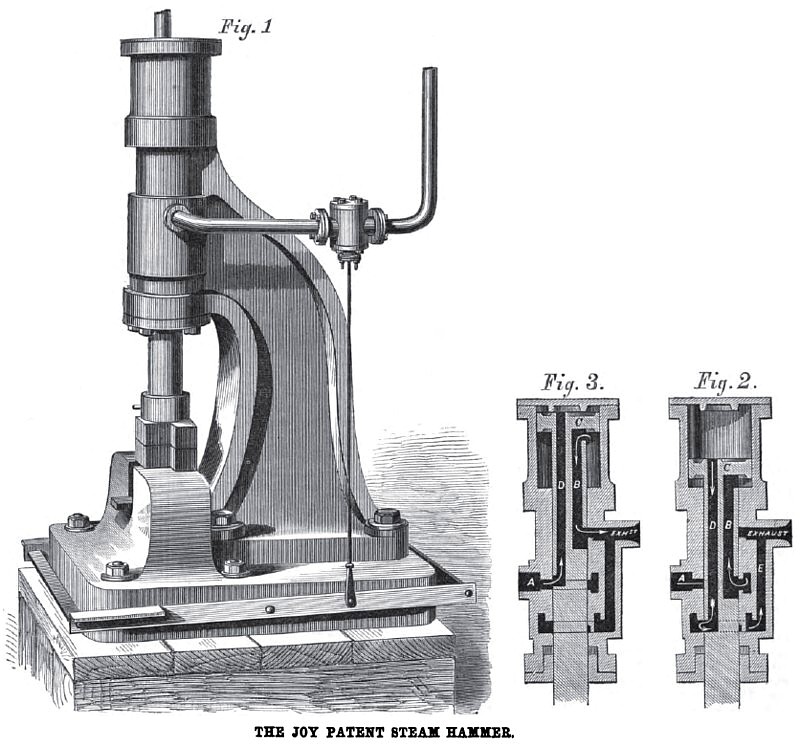|
Title: |
1868 Article-Merrick & Sons, Steam Hammer |
|
Source: |
Scientific American 28 Oct 1868 pg 277 |
|
Insert Date: |
5/2/2012 1:24:38 PM |
Improved. Direct-Acting Steam Hammer.
Simplicity being, next to efficiency, the most important point to be aimed at in the design of steam hammers, the form illustrated in the annexed engravings should commend itself to all who have occasion to use this class of tools. There being, with the exception of the regulating valve, but one moving part in this hammer, there seems to be nothing left to be attained on the score of simplicity. Fig. 1 is a perspective view of the hammer, and Figs. 2 and 3 vertical sections showing two positions of the hammer.
The ram being down, as in Fig. 3, steam is admitted to the annular channel, A, and from thence in the direction of the arrow, through the vertical passage, B, to the under side of the piston, C, the passage, D, communicating through the piston with the portion of the cylinder above the piston, being open to the exhaust as seen, whatever steam there may be above the piston escaping in the direction shown by the arrows through the passage, E, to the exhaust. The steam admitted at A, and passing up the passage, B, lifts the piston until the passage, D, connecting above the piston, opens to the steam inlet admitting steam over the piston. Notwithstanding this, the momentum of the ram continues the upward stroke until the passage, B, opens to the upper exhaust, when the parts are in the position seen in Fig. 3, to which we will now direct our attention, similar letters denoting the same parts.
The pressure of steam above the piston combines with the weight of the ram to carry it down with great force, until the passage, B, is uncovered to the steam inlet, A, and the passage, D, is open to the lower exhaust port, when the motion is reversed, the piston cushioning on the steam admitted through B.
The admission of steam and consequent speed of the hammer is regulated and governed by the foot of the forger, as plainly shown in Fig. 1. A hand gate also may be placed on the steam pipe if desired. Thus a slow and light blow, or a rapid and heavy one can be obtained at pleasure. For work requiring rapid and uniform blows, such as drawing small steel, making cutlery or edge tools, planishing saws, etc., this is a very efficient hammer. We witnessed its operation at the works of the
American Tool Steel Company, corner Kent avenue and Keap street, Brooklyn, E. D., N. Y., with great satisfaction. This hammer is the invention of David Joy, of England, and has been patented in this country by Merrick & Sons, 430 Washington avenue, Philadelphia, Pa. For terms and prices address as above, or Geo. Birkbeck, Jr., the agent at their office, 03 Broadway, New York city.
Patent #80,550 |
|
 1868 Merrick & Sons, Steam Hammer
1868 Merrick & Sons, Steam Hammer
|
|